LINCOLN MKZ HYBRID 2013 Owners Manual
Manufacturer: LINCOLN, Model Year: 2013, Model line: MKZ HYBRID, Model: LINCOLN MKZ HYBRID 2013Pages: 475, PDF Size: 3.89 MB
Page 281 of 475
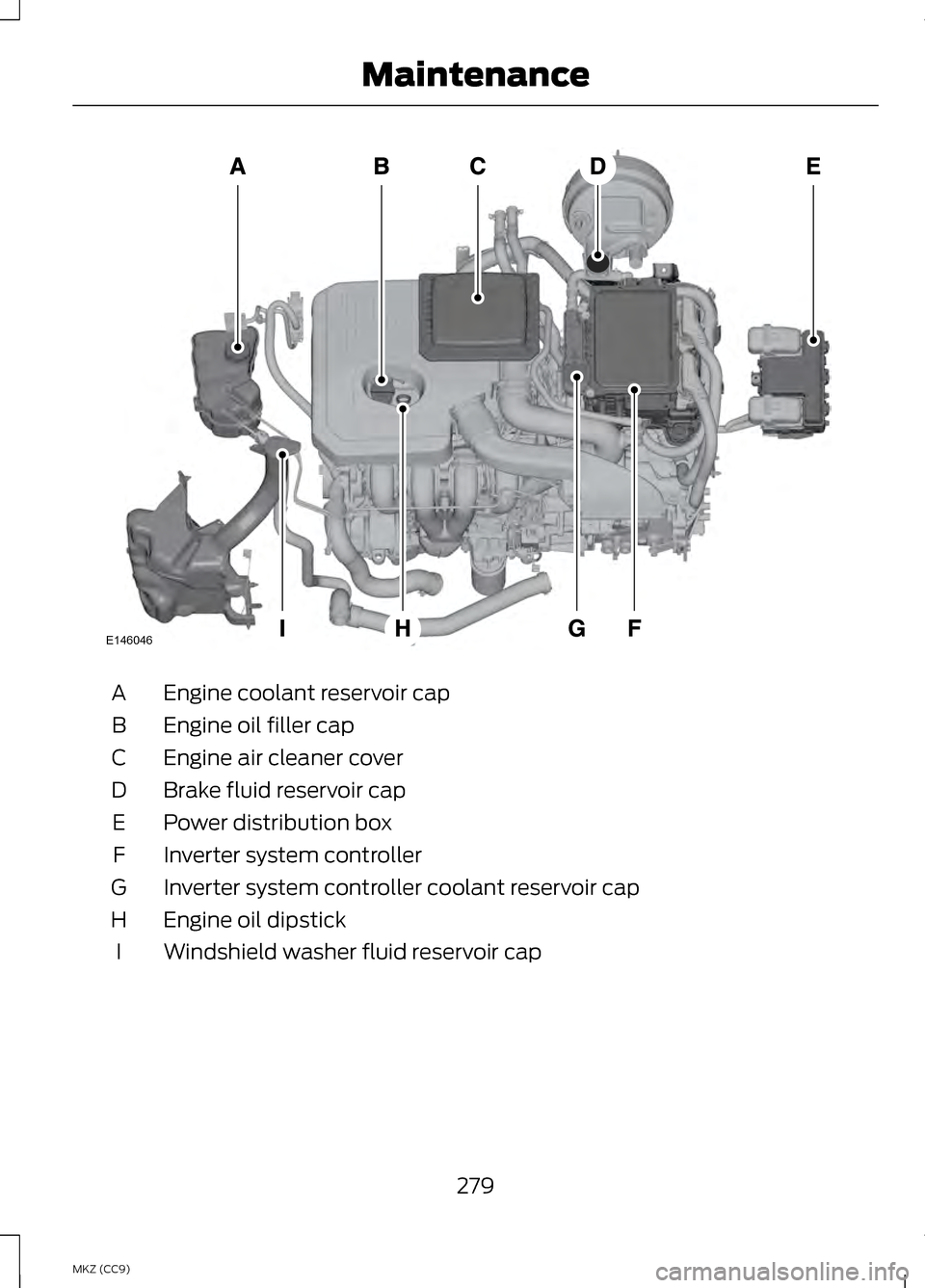
Engine coolant reservoir cap
A
Engine oil filler cap
B
Engine air cleaner cover
C
Brake fluid reservoir cap
D
Power distribution box
E
Inverter system controller
F
Inverter system controller coolant reservoir cap
G
Engine oil dipstick
H
Windshield washer fluid reservoir cap
I
279
MKZ (CC9) MaintenanceE146046
Page 282 of 475
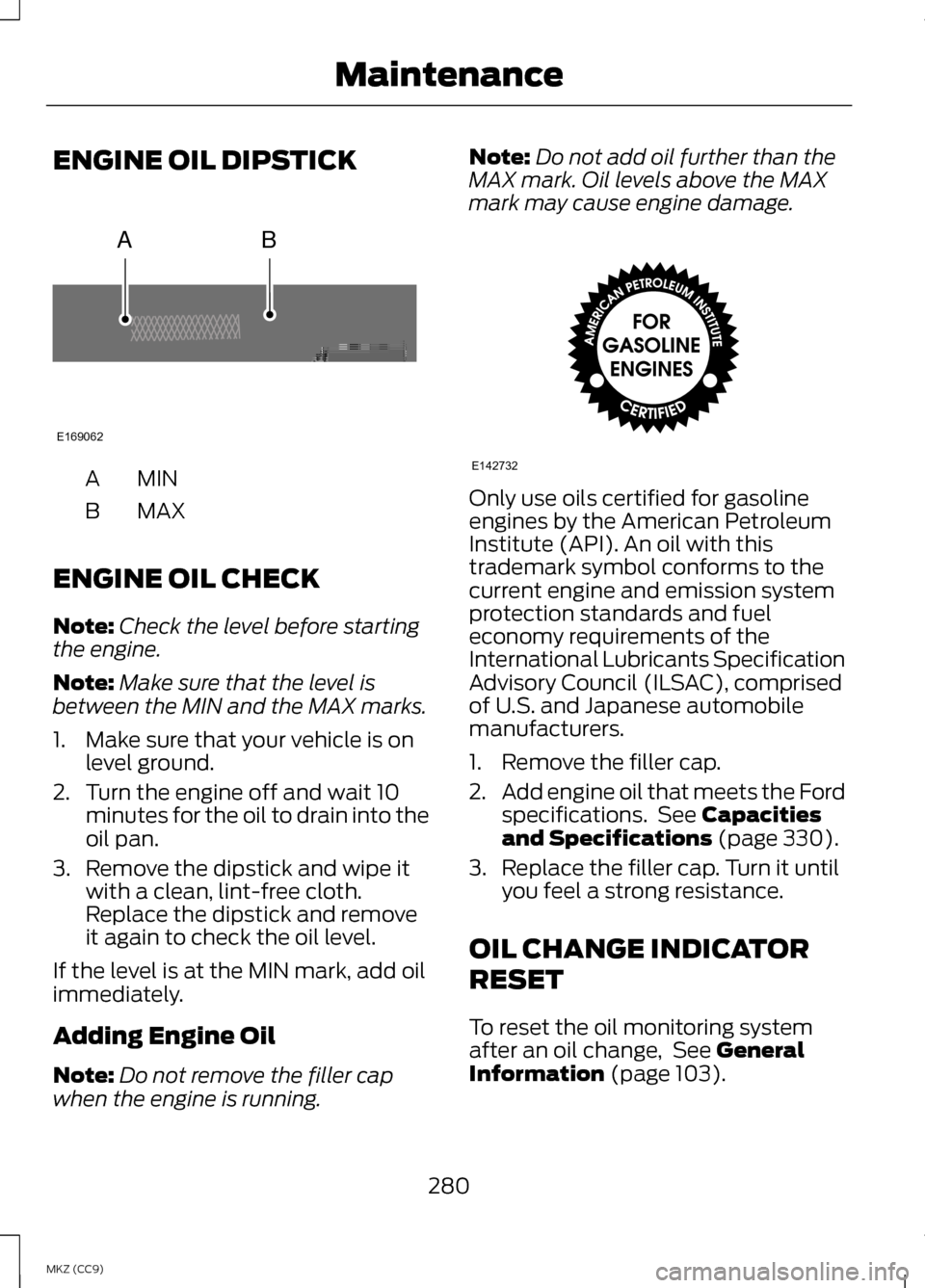
ENGINE OIL DIPSTICK
MINA
MAXB
ENGINE OIL CHECK
Note: Check the level before starting
the engine.
Note: Make sure that the level is
between the MIN and the MAX marks.
1. Make sure that your vehicle is on level ground.
2. Turn the engine off and wait 10 minutes for the oil to drain into the
oil pan.
3. Remove the dipstick and wipe it with a clean, lint-free cloth.
Replace the dipstick and remove
it again to check the oil level.
If the level is at the MIN mark, add oil
immediately.
Adding Engine Oil
Note: Do not remove the filler cap
when the engine is running. Note:
Do not add oil further than the
MAX mark. Oil levels above the MAX
mark may cause engine damage. Only use oils certified for gasoline
engines by the American Petroleum
Institute (API). An oil with this
trademark symbol conforms to the
current engine and emission system
protection standards and fuel
economy requirements of the
International Lubricants Specification
Advisory Council (ILSAC), comprised
of U.S. and Japanese automobile
manufacturers.
1. Remove the filler cap.
2.
Add engine oil that meets the Ford
specifications. See Capacities
and Specifications (page 330).
3. Replace the filler cap. Turn it until you feel a strong resistance.
OIL CHANGE INDICATOR
RESET
To reset the oil monitoring system
after an oil change, See
General
Information (page 103).
280
MKZ (CC9) MaintenanceAB
E169062 E142732
Page 283 of 475
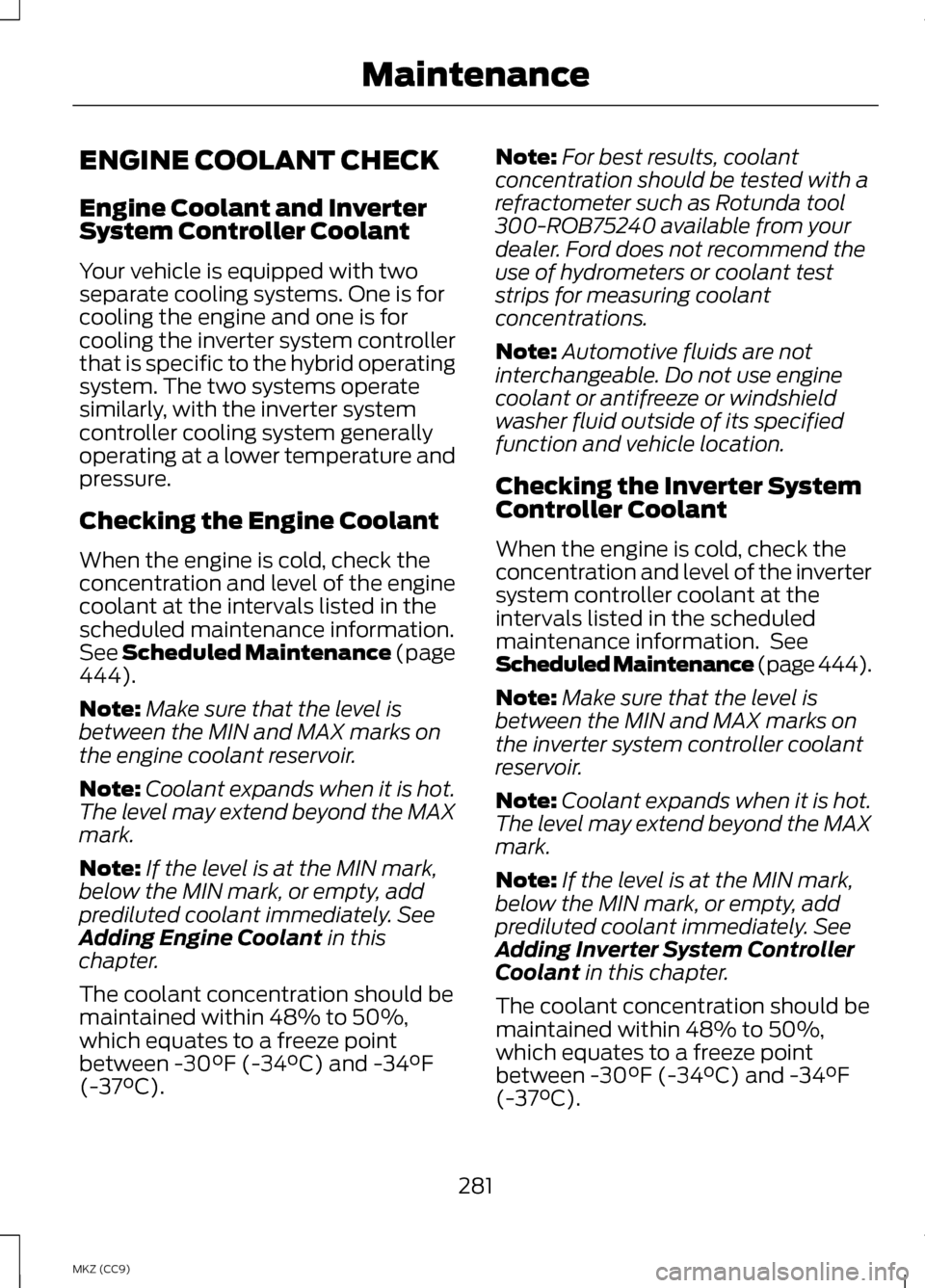
ENGINE COOLANT CHECK
Engine Coolant and Inverter
System Controller Coolant
Your vehicle is equipped with two
separate cooling systems. One is for
cooling the engine and one is for
cooling the inverter system controller
that is specific to the hybrid operating
system. The two systems operate
similarly, with the inverter system
controller cooling system generally
operating at a lower temperature and
pressure.
Checking the Engine Coolant
When the engine is cold, check the
concentration and level of the engine
coolant at the intervals listed in the
scheduled maintenance information.
See Scheduled Maintenance (page
444).
Note: Make sure that the level is
between the MIN and MAX marks on
the engine coolant reservoir.
Note: Coolant expands when it is hot.
The level may extend beyond the MAX
mark.
Note: If the level is at the MIN mark,
below the MIN mark, or empty, add
prediluted coolant immediately. See
Adding Engine Coolant
in this
chapter.
The coolant concentration should be
maintained within 48% to 50%,
which equates to a freeze point
between -30°F (-34°C) and -34°F
(-37°C). Note:
For best results, coolant
concentration should be tested with a
refractometer such as Rotunda tool
300-ROB75240 available from your
dealer. Ford does not recommend the
use of hydrometers or coolant test
strips for measuring coolant
concentrations.
Note: Automotive fluids are not
interchangeable. Do not use engine
coolant or antifreeze or windshield
washer fluid outside of its specified
function and vehicle location.
Checking the Inverter System
Controller Coolant
When the engine is cold, check the
concentration and level of the inverter
system controller coolant at the
intervals listed in the scheduled
maintenance information. See
Scheduled Maintenance (page 444).
Note: Make sure that the level is
between the MIN and MAX marks on
the inverter system controller coolant
reservoir.
Note: Coolant expands when it is hot.
The level may extend beyond the MAX
mark.
Note: If the level is at the MIN mark,
below the MIN mark, or empty, add
prediluted coolant immediately. See
Adding Inverter System Controller
Coolant
in this chapter.
The coolant concentration should be
maintained within 48% to 50%,
which equates to a freeze point
between -30°F (-34°C) and -34°F
(-37°C).
281
MKZ (CC9) Maintenance
Page 284 of 475
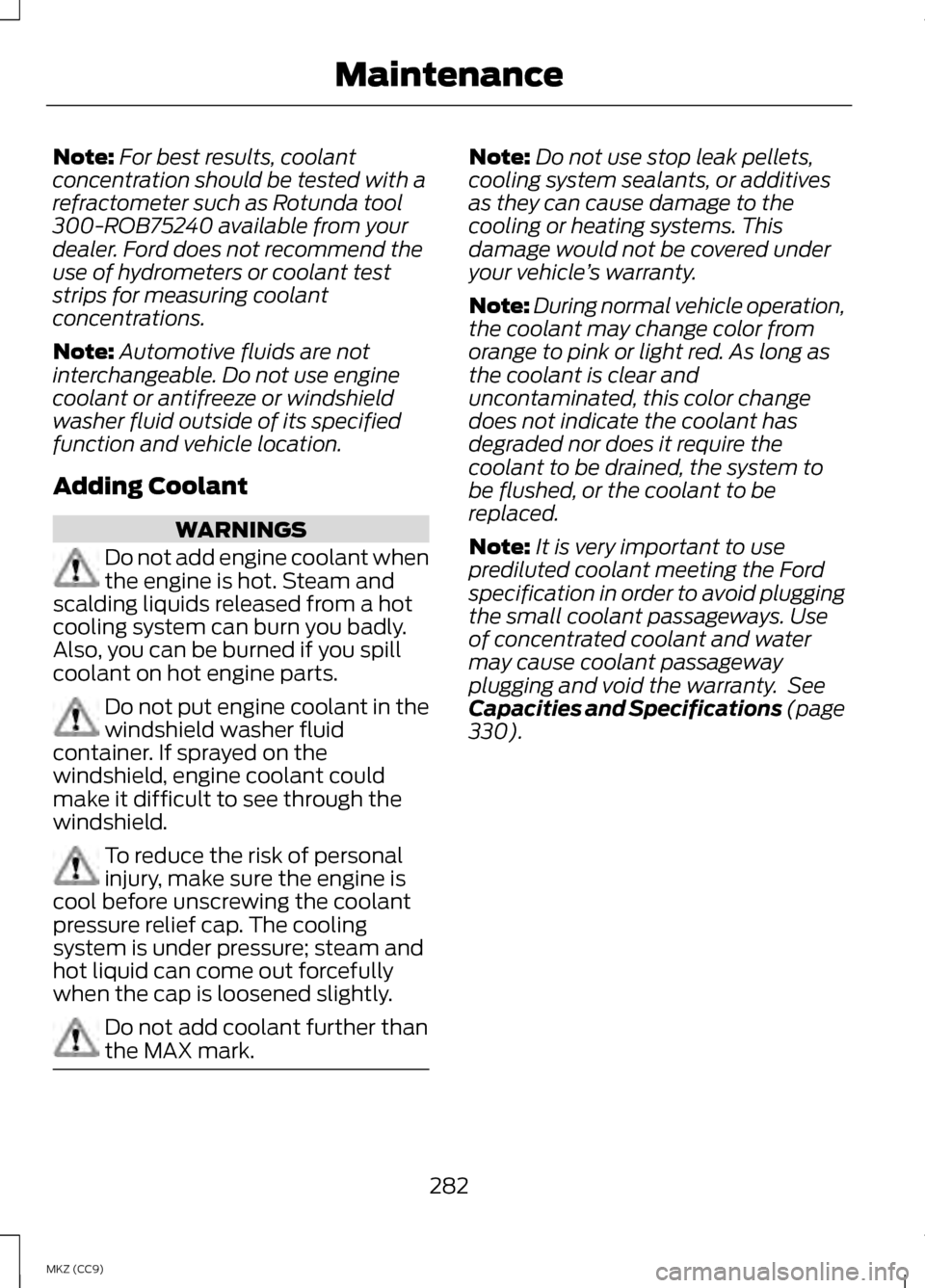
Note:
For best results, coolant
concentration should be tested with a
refractometer such as Rotunda tool
300-ROB75240 available from your
dealer. Ford does not recommend the
use of hydrometers or coolant test
strips for measuring coolant
concentrations.
Note: Automotive fluids are not
interchangeable. Do not use engine
coolant or antifreeze or windshield
washer fluid outside of its specified
function and vehicle location.
Adding Coolant WARNINGS
Do not add engine coolant when
the engine is hot. Steam and
scalding liquids released from a hot
cooling system can burn you badly.
Also, you can be burned if you spill
coolant on hot engine parts. Do not put engine coolant in the
windshield washer fluid
container. If sprayed on the
windshield, engine coolant could
make it difficult to see through the
windshield. To reduce the risk of personal
injury, make sure the engine is
cool before unscrewing the coolant
pressure relief cap. The cooling
system is under pressure; steam and
hot liquid can come out forcefully
when the cap is loosened slightly. Do not add coolant further than
the MAX mark. Note:
Do not use stop leak pellets,
cooling system sealants, or additives
as they can cause damage to the
cooling or heating systems. This
damage would not be covered under
your vehicle ’s warranty.
Note: During normal vehicle operation,
the coolant may change color from
orange to pink or light red. As long as
the coolant is clear and
uncontaminated, this color change
does not indicate the coolant has
degraded nor does it require the
coolant to be drained, the system to
be flushed, or the coolant to be
replaced.
Note: It is very important to use
prediluted coolant meeting the Ford
specification in order to avoid plugging
the small coolant passageways. Use
of concentrated coolant and water
may cause coolant passageway
plugging and void the warranty. See
Capacities and Specifications (page
330).
282
MKZ (CC9) Maintenance
Page 285 of 475
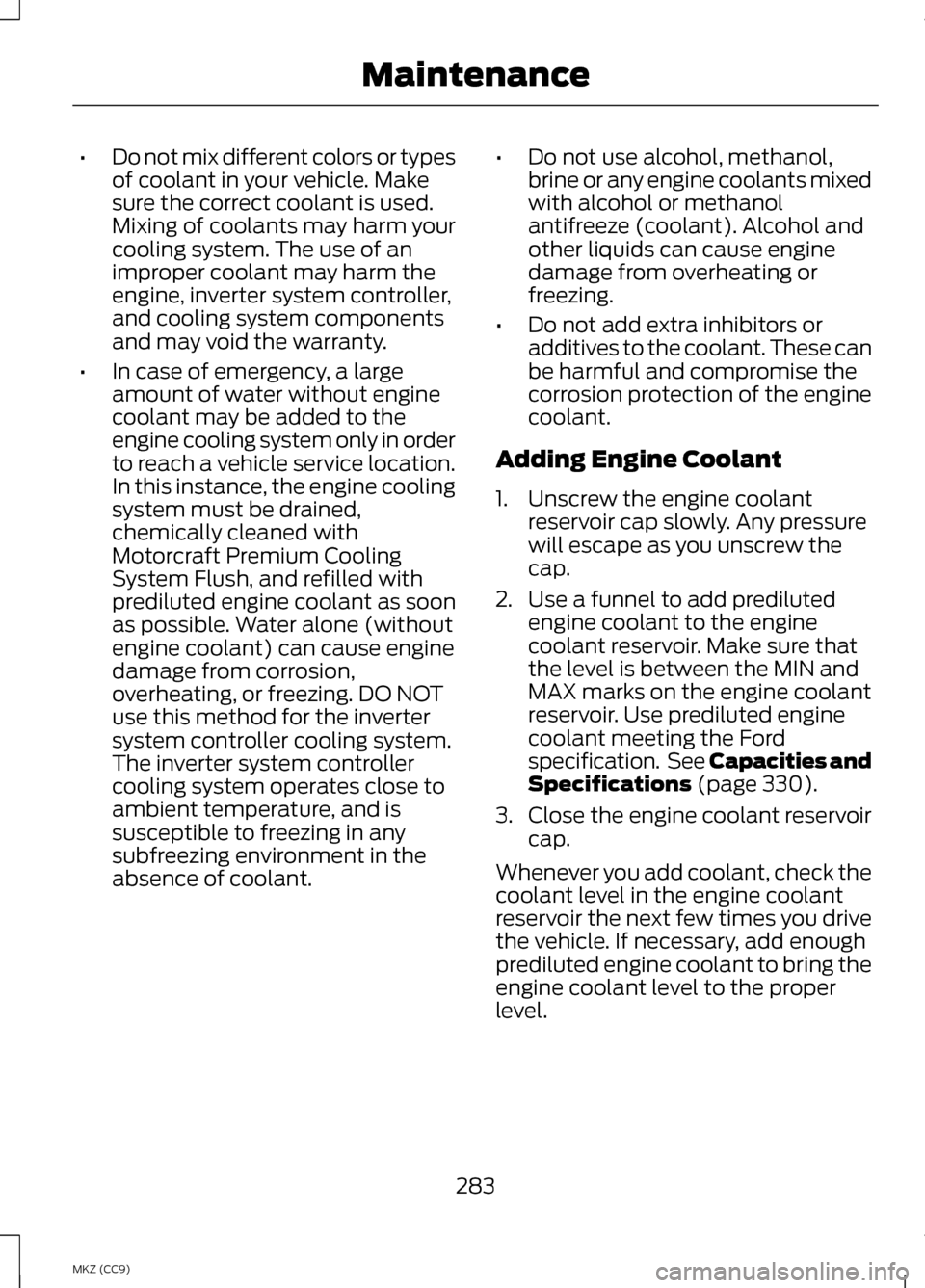
•
Do not mix different colors or types
of coolant in your vehicle. Make
sure the correct coolant is used.
Mixing of coolants may harm your
cooling system. The use of an
improper coolant may harm the
engine, inverter system controller,
and cooling system components
and may void the warranty.
• In case of emergency, a large
amount of water without engine
coolant may be added to the
engine cooling system only in order
to reach a vehicle service location.
In this instance, the engine cooling
system must be drained,
chemically cleaned with
Motorcraft Premium Cooling
System Flush, and refilled with
prediluted engine coolant as soon
as possible. Water alone (without
engine coolant) can cause engine
damage from corrosion,
overheating, or freezing. DO NOT
use this method for the inverter
system controller cooling system.
The inverter system controller
cooling system operates close to
ambient temperature, and is
susceptible to freezing in any
subfreezing environment in the
absence of coolant. •
Do not use alcohol, methanol,
brine or any engine coolants mixed
with alcohol or methanol
antifreeze (coolant). Alcohol and
other liquids can cause engine
damage from overheating or
freezing.
• Do not add extra inhibitors or
additives to the coolant. These can
be harmful and compromise the
corrosion protection of the engine
coolant.
Adding Engine Coolant
1. Unscrew the engine coolant reservoir cap slowly. Any pressure
will escape as you unscrew the
cap.
2. Use a funnel to add prediluted engine coolant to the engine
coolant reservoir. Make sure that
the level is between the MIN and
MAX marks on the engine coolant
reservoir. Use prediluted engine
coolant meeting the Ford
specification. See Capacities and
Specifications (page 330).
3. Close the engine coolant reservoir
cap.
Whenever you add coolant, check the
coolant level in the engine coolant
reservoir the next few times you drive
the vehicle. If necessary, add enough
prediluted engine coolant to bring the
engine coolant level to the proper
level.
283
MKZ (CC9) Maintenance
Page 286 of 475
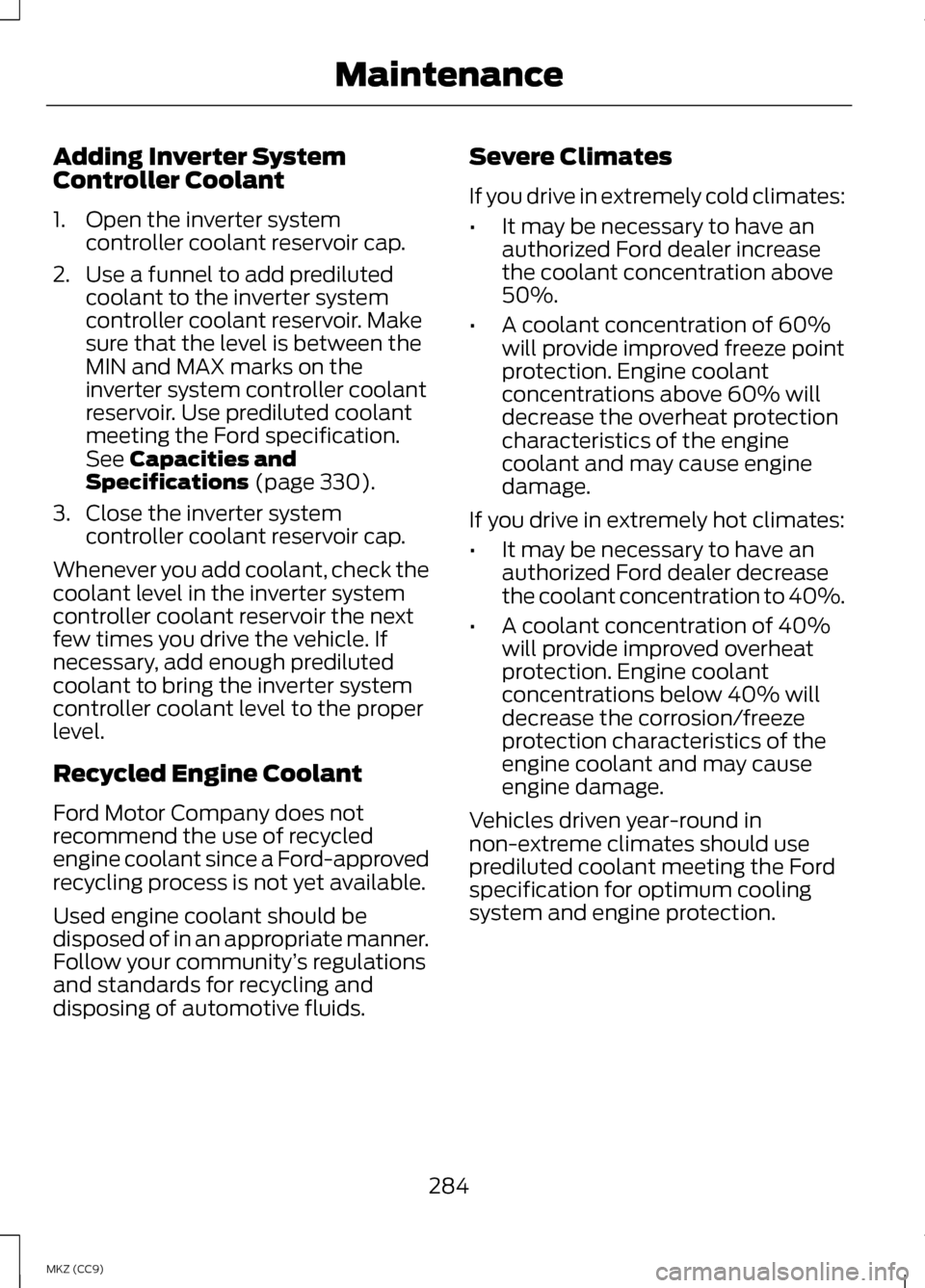
Adding Inverter System
Controller Coolant
1. Open the inverter system
controller coolant reservoir cap.
2. Use a funnel to add prediluted coolant to the inverter system
controller coolant reservoir. Make
sure that the level is between the
MIN and MAX marks on the
inverter system controller coolant
reservoir. Use prediluted coolant
meeting the Ford specification.
See Capacities and
Specifications (page 330).
3. Close the inverter system controller coolant reservoir cap.
Whenever you add coolant, check the
coolant level in the inverter system
controller coolant reservoir the next
few times you drive the vehicle. If
necessary, add enough prediluted
coolant to bring the inverter system
controller coolant level to the proper
level.
Recycled Engine Coolant
Ford Motor Company does not
recommend the use of recycled
engine coolant since a Ford-approved
recycling process is not yet available.
Used engine coolant should be
disposed of in an appropriate manner.
Follow your community ’s regulations
and standards for recycling and
disposing of automotive fluids. Severe Climates
If you drive in extremely cold climates:
•
It may be necessary to have an
authorized Ford dealer increase
the coolant concentration above
50%.
• A coolant concentration of 60%
will provide improved freeze point
protection. Engine coolant
concentrations above 60% will
decrease the overheat protection
characteristics of the engine
coolant and may cause engine
damage.
If you drive in extremely hot climates:
• It may be necessary to have an
authorized Ford dealer decrease
the coolant concentration to 40%.
• A coolant concentration of 40%
will provide improved overheat
protection. Engine coolant
concentrations below 40% will
decrease the corrosion/freeze
protection characteristics of the
engine coolant and may cause
engine damage.
Vehicles driven year-round in
non-extreme climates should use
prediluted coolant meeting the Ford
specification for optimum cooling
system and engine protection.
284
MKZ (CC9) Maintenance
Page 287 of 475
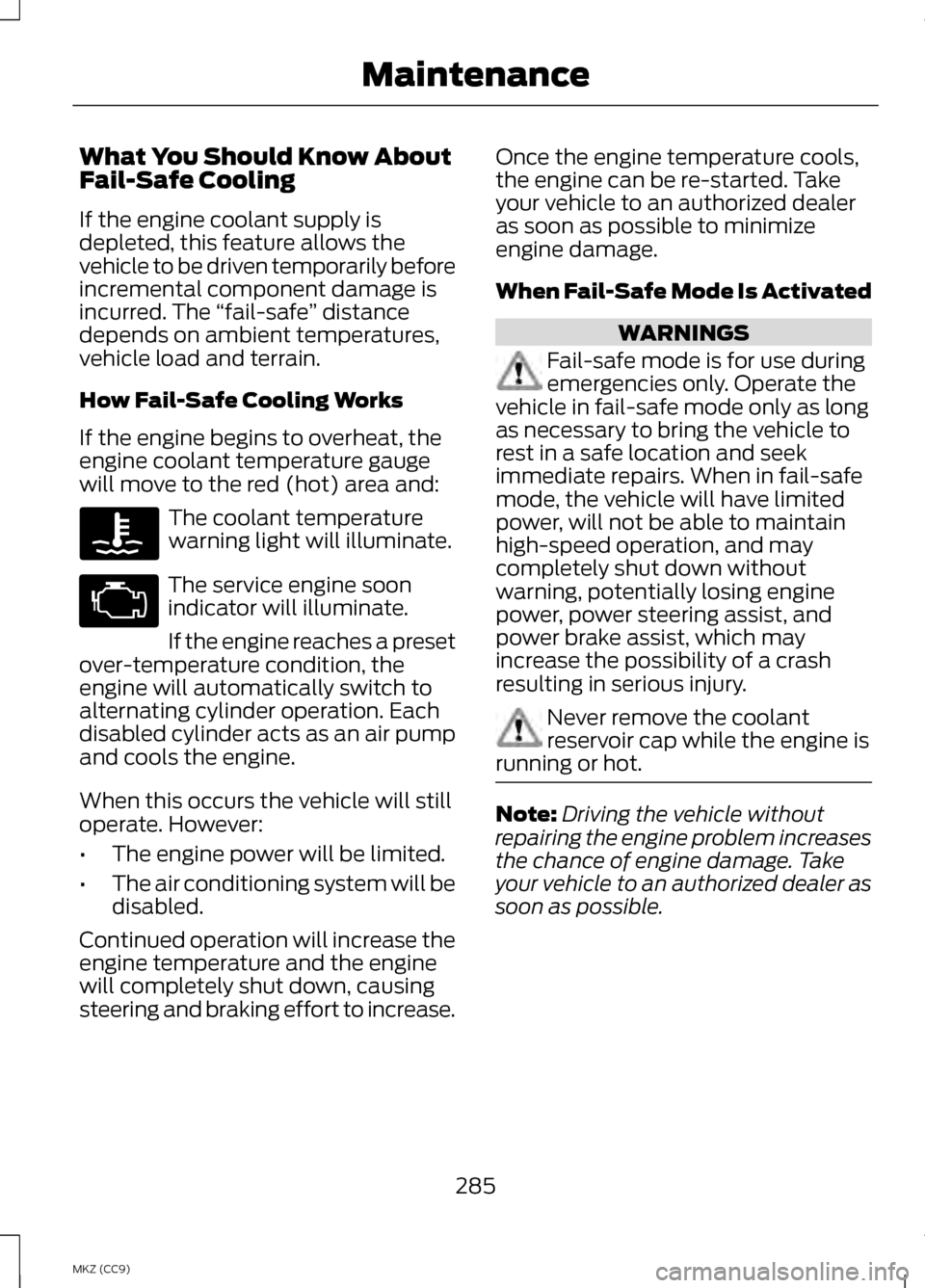
What You Should Know About
Fail-Safe Cooling
If the engine coolant supply is
depleted, this feature allows the
vehicle to be driven temporarily before
incremental component damage is
incurred. The
“fail-safe” distance
depends on ambient temperatures,
vehicle load and terrain.
How Fail-Safe Cooling Works
If the engine begins to overheat, the
engine coolant temperature gauge
will move to the red (hot) area and: The coolant temperature
warning light will illuminate.
The service engine soon
indicator will illuminate.
If the engine reaches a preset
over-temperature condition, the
engine will automatically switch to
alternating cylinder operation. Each
disabled cylinder acts as an air pump
and cools the engine.
When this occurs the vehicle will still
operate. However:
• The engine power will be limited.
• The air conditioning system will be
disabled.
Continued operation will increase the
engine temperature and the engine
will completely shut down, causing
steering and braking effort to increase. Once the engine temperature cools,
the engine can be re-started. Take
your vehicle to an authorized dealer
as soon as possible to minimize
engine damage.
When Fail-Safe Mode Is Activated WARNINGS
Fail-safe mode is for use during
emergencies only. Operate the
vehicle in fail-safe mode only as long
as necessary to bring the vehicle to
rest in a safe location and seek
immediate repairs. When in fail-safe
mode, the vehicle will have limited
power, will not be able to maintain
high-speed operation, and may
completely shut down without
warning, potentially losing engine
power, power steering assist, and
power brake assist, which may
increase the possibility of a crash
resulting in serious injury. Never remove the coolant
reservoir cap while the engine is
running or hot. Note:
Driving the vehicle without
repairing the engine problem increases
the chance of engine damage. Take
your vehicle to an authorized dealer as
soon as possible.
285
MKZ (CC9) Maintenance
Page 288 of 475
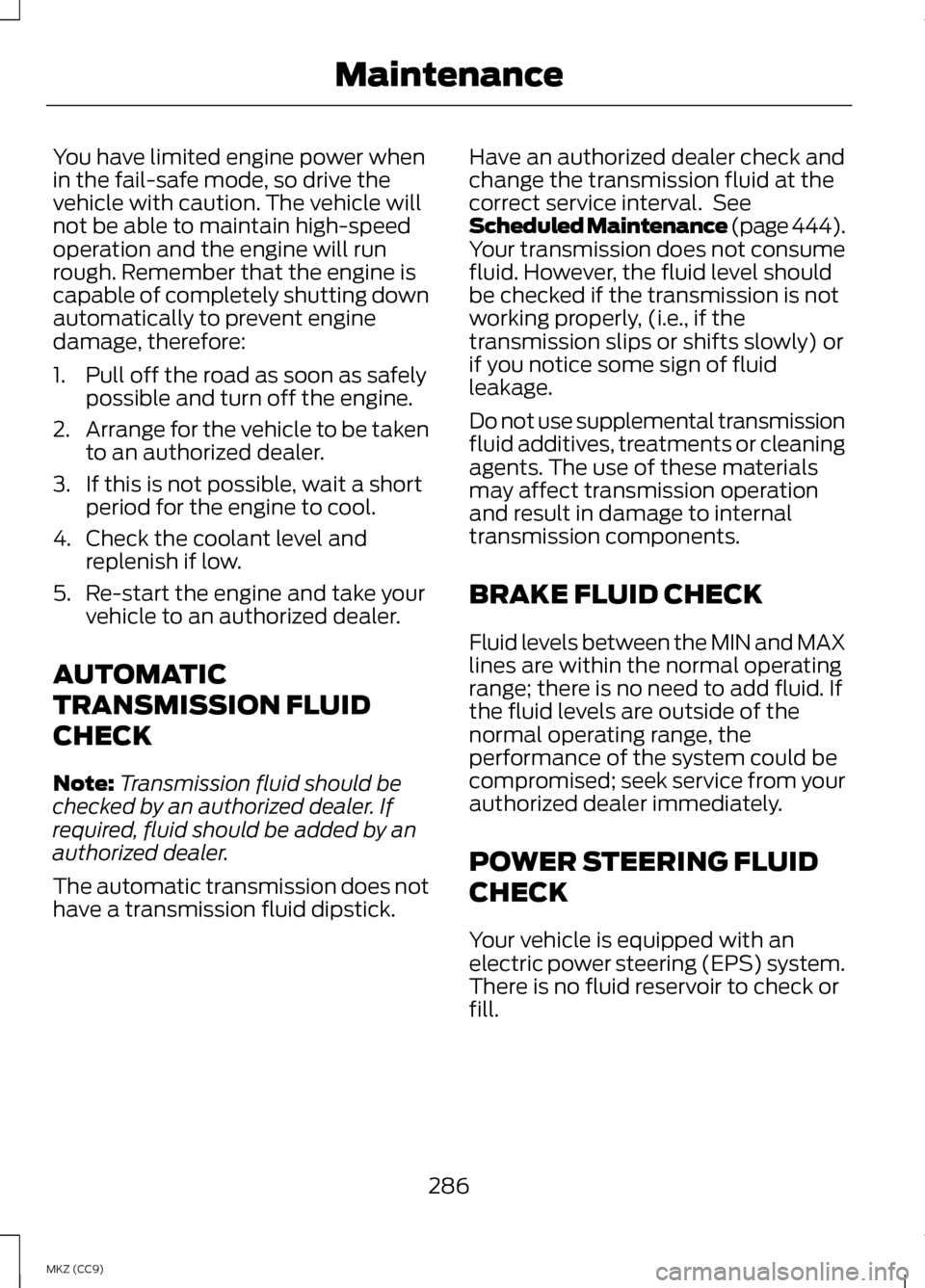
You have limited engine power when
in the fail-safe mode, so drive the
vehicle with caution. The vehicle will
not be able to maintain high-speed
operation and the engine will run
rough. Remember that the engine is
capable of completely shutting down
automatically to prevent engine
damage, therefore:
1. Pull off the road as soon as safely
possible and turn off the engine.
2. Arrange for the vehicle to be taken
to an authorized dealer.
3. If this is not possible, wait a short period for the engine to cool.
4. Check the coolant level and replenish if low.
5. Re-start the engine and take your vehicle to an authorized dealer.
AUTOMATIC
TRANSMISSION FLUID
CHECK
Note: Transmission fluid should be
checked by an authorized dealer. If
required, fluid should be added by an
authorized dealer.
The automatic transmission does not
have a transmission fluid dipstick. Have an authorized dealer check and
change the transmission fluid at the
correct service interval. See
Scheduled Maintenance (page 444).
Your transmission does not consume
fluid. However, the fluid level should
be checked if the transmission is not
working properly, (i.e., if the
transmission slips or shifts slowly) or
if you notice some sign of fluid
leakage.
Do not use supplemental transmission
fluid additives, treatments or cleaning
agents. The use of these materials
may affect transmission operation
and result in damage to internal
transmission components.
BRAKE FLUID CHECK
Fluid levels between the MIN and MAX
lines are within the normal operating
range; there is no need to add fluid. If
the fluid levels are outside of the
normal operating range, the
performance of the system could be
compromised; seek service from your
authorized dealer immediately.
POWER STEERING FLUID
CHECK
Your vehicle is equipped with an
electric power steering (EPS) system.
There is no fluid reservoir to check or
fill.
286
MKZ (CC9) Maintenance
Page 289 of 475
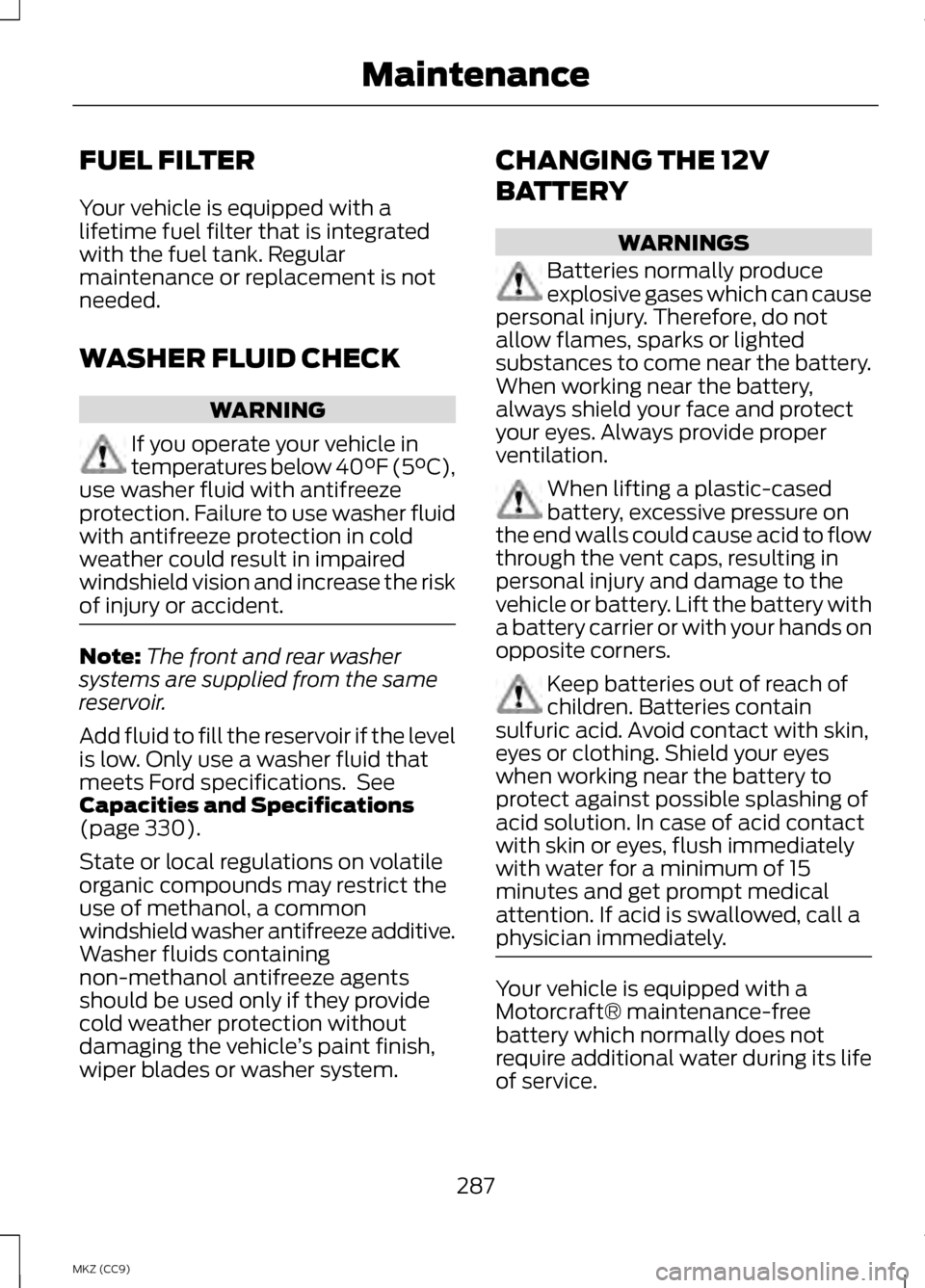
FUEL FILTER
Your vehicle is equipped with a
lifetime fuel filter that is integrated
with the fuel tank. Regular
maintenance or replacement is not
needed.
WASHER FLUID CHECK
WARNING
If you operate your vehicle in
temperatures below 40°F (5°C),
use washer fluid with antifreeze
protection. Failure to use washer fluid
with antifreeze protection in cold
weather could result in impaired
windshield vision and increase the risk
of injury or accident. Note:
The front and rear washer
systems are supplied from the same
reservoir.
Add fluid to fill the reservoir if the level
is low. Only use a washer fluid that
meets Ford specifications. See
Capacities and Specifications
(page 330).
State or local regulations on volatile
organic compounds may restrict the
use of methanol, a common
windshield washer antifreeze additive.
Washer fluids containing
non-methanol antifreeze agents
should be used only if they provide
cold weather protection without
damaging the vehicle ’s paint finish,
wiper blades or washer system. CHANGING THE 12V
BATTERY WARNINGS
Batteries normally produce
explosive gases which can cause
personal injury. Therefore, do not
allow flames, sparks or lighted
substances to come near the battery.
When working near the battery,
always shield your face and protect
your eyes. Always provide proper
ventilation. When lifting a plastic-cased
battery, excessive pressure on
the end walls could cause acid to flow
through the vent caps, resulting in
personal injury and damage to the
vehicle or battery. Lift the battery with
a battery carrier or with your hands on
opposite corners. Keep batteries out of reach of
children. Batteries contain
sulfuric acid. Avoid contact with skin,
eyes or clothing. Shield your eyes
when working near the battery to
protect against possible splashing of
acid solution. In case of acid contact
with skin or eyes, flush immediately
with water for a minimum of 15
minutes and get prompt medical
attention. If acid is swallowed, call a
physician immediately. Your vehicle is equipped with a
Motorcraft® maintenance-free
battery which normally does not
require additional water during its life
of service.
287
MKZ (CC9) Maintenance
Page 290 of 475
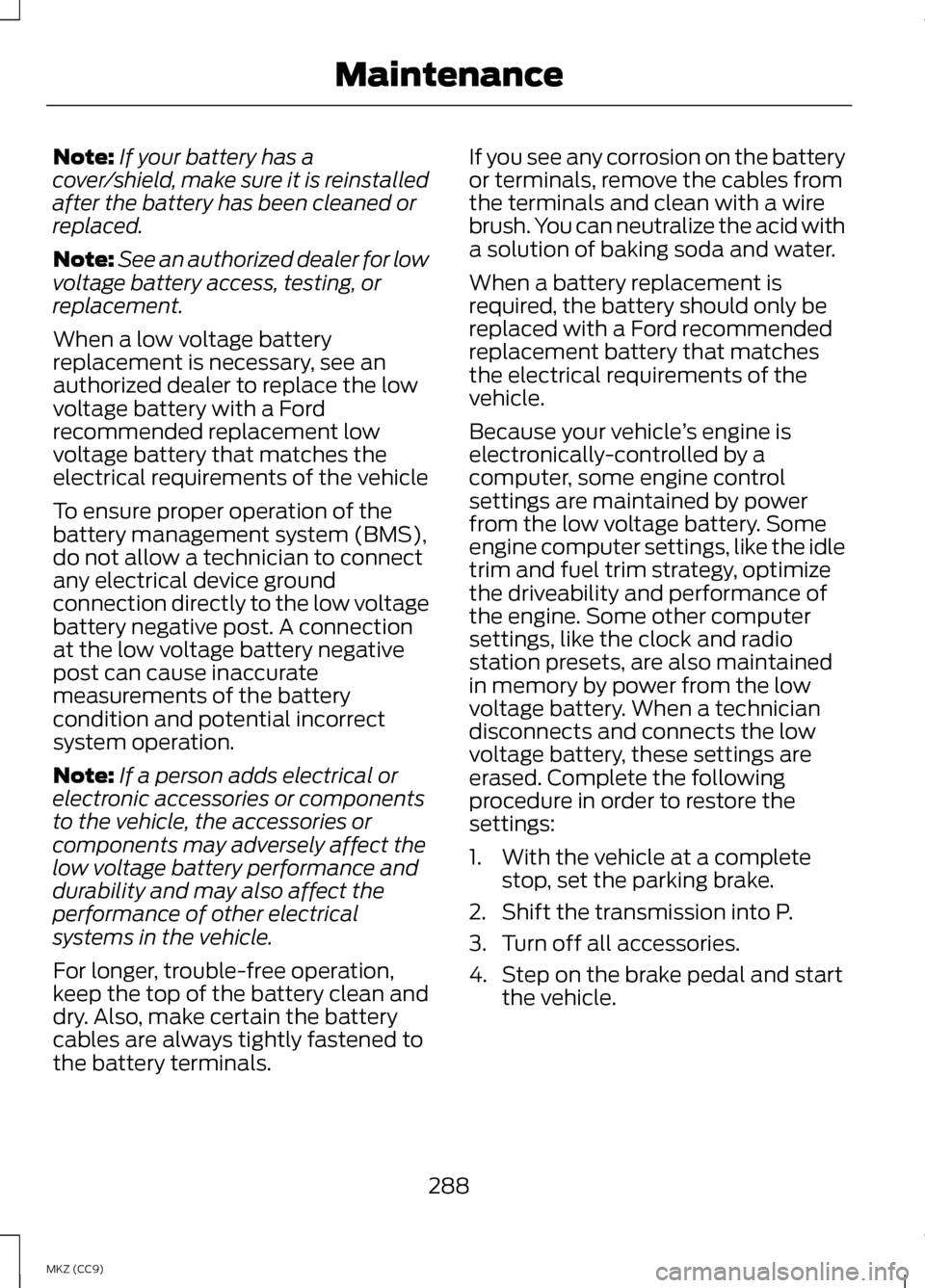
Note:
If your battery has a
cover/shield, make sure it is reinstalled
after the battery has been cleaned or
replaced.
Note: See an authorized dealer for low
voltage battery access, testing, or
replacement.
When a low voltage battery
replacement is necessary, see an
authorized dealer to replace the low
voltage battery with a Ford
recommended replacement low
voltage battery that matches the
electrical requirements of the vehicle
To ensure proper operation of the
battery management system (BMS),
do not allow a technician to connect
any electrical device ground
connection directly to the low voltage
battery negative post. A connection
at the low voltage battery negative
post can cause inaccurate
measurements of the battery
condition and potential incorrect
system operation.
Note: If a person adds electrical or
electronic accessories or components
to the vehicle, the accessories or
components may adversely affect the
low voltage battery performance and
durability and may also affect the
performance of other electrical
systems in the vehicle.
For longer, trouble-free operation,
keep the top of the battery clean and
dry. Also, make certain the battery
cables are always tightly fastened to
the battery terminals. If you see any corrosion on the battery
or terminals, remove the cables from
the terminals and clean with a wire
brush. You can neutralize the acid with
a solution of baking soda and water.
When a battery replacement is
required, the battery should only be
replaced with a Ford recommended
replacement battery that matches
the electrical requirements of the
vehicle.
Because your vehicle
’s engine is
electronically-controlled by a
computer, some engine control
settings are maintained by power
from the low voltage battery. Some
engine computer settings, like the idle
trim and fuel trim strategy, optimize
the driveability and performance of
the engine. Some other computer
settings, like the clock and radio
station presets, are also maintained
in memory by power from the low
voltage battery. When a technician
disconnects and connects the low
voltage battery, these settings are
erased. Complete the following
procedure in order to restore the
settings:
1. With the vehicle at a complete stop, set the parking brake.
2. Shift the transmission into P.
3. Turn off all accessories.
4. Step on the brake pedal and start the vehicle.
288
MKZ (CC9) Maintenance